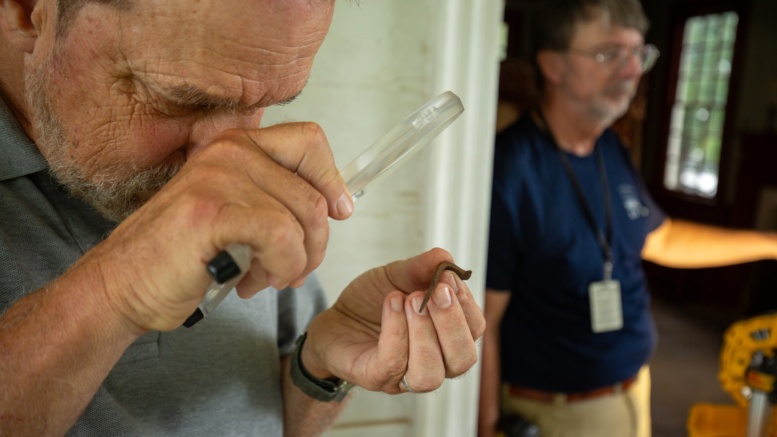BY LAURA DOUGLASS
Insider Staff Writer
The Alston House — better known as the House in the Horseshoe — is one of only a few known surviving houses from the American Revolution that still bear the scars of the war. Phillip Alston and a small band of patriot militia were besieged at the property on July 29, 1781, by forces loyal to King George III, under the command of David Fanning. The attack was in retaliation for the violent death of Loyalist Kenneth Black, which had occurred several days prior in what is now Southern Pines.
According to reports, Alston ordered his men to barricade the doors and windows while Fanning posted his men along a split rail fence outside the home. For several hours, the men exchanged fire. Inside the home, Temperance Alston, Phillip’s wife, hid her children in the chimney so they would be protected by the brickwork. When Fanning’s men set a small wagon afire with the purpose of pushing it into the house, Temperance stepped onto the porch to negotiate a surrender.
In recent weeks, agents with the State Bureau of Investigation crime team have collected samples and conducted a ballistic analysis of the walls — more than 30 bullet “defects” still mark the exterior and interior of the home — as part of major renovation work underway at the Alston House through a a $444,926 grant from the National Park Service Semiquincentennial Grant Program of the Historic Preservation Fund (HPF).
“This was a project on my radar and it was the right time to do it because we were opening a wall,” said Amanda Brantley, site manager of the House in the Horseshoe. “The spent all day putting ballistic rods in the bullet holes and mapped each one, measured the angles and photographed the entire exterior to create a 3-D scan, which will render a 3-D model of the house with the bullet trajectories.”
Brantley said written records indicate the Loyalists surrounded the house but the new analysis will provide detailed information about where they were standing when shots were fired. “This is very exciting for interpretive purposes. We know they likely would have used outbuildings for protection and cover, and we have a general idea of where those were. Now we can see if there was a concentration of them here or there.”
Following the American Revolution, the home was owned by four-term governor Benjamin Williams and is now owned by the state. In 1954, the Moore County Historical Association restored the house, which now features antiques from the colonial and Revolutionary War eras.
Last year as part of the 250th birthday celebration of the Alston House, Brantley said she dug up old photos and information including a paint analysis of the house, completed in 2000. “We color coded the house with what colors were appropriate to what era and then stepped back and realized, wow, we still have a lot of questions.”

An old HVAC system was causing plaster issues in the attic and as Brantley and a state grant writer toured the house, there were questions about the structure itself. “What did the house look like when it was constructed? And what did it look like during the battle?” said Brantley, noting the house had wings attached to either side, which were torn off in 1911. “Our purpose is to find out what the house looked like during the American Revolution.”
The HPF grant is providing funding for substantial needed repairs, including treating all lumber exposed to the elements for mold and termites, installing a new HVAC system and new signage for visitors, in addition to the historic structures report to understand how the home has evolved over the years and a paint analysis to restore colors to the original scheme, and updating the nomination to the National Register of Historic Places to include more research.
During Alston’s tenure, Brantley explained, the entire first floor was painted red — from floor to ceiling — a sign of wealth in Colonial times. “It is an educational aspect of the house. It wasn’t just whitewashed walls. The Georgian period was very colorful.”
Later on when Gov. Williams lived in the home, the walls were painted a glossy white. The exterior has been white “as long as anyone remembers,” Brantley said, “but it may have been white or another color. Hopefully the paint analysis will come back and tell us. Repainting the exterior would be part of this grant. Right now we are in the study phase of the house.”
In 2023, the National Park Services awarded $10 million in the second round of funding from the Semiquincentennial Grant Program commemorating the 250th anniversary of the founding of the United States. Created by Congress in 2020 and funded through the Historic Preservation Fund (HPF), this round of grants supported 20 cultural resource preservation projects across 14 states, including the House in the Horseshoe — the only grant project selected in North Carolina for this funding.
Established in 1977, the HPF is authorized at $150 million per year through 2023 and has provided more than $2 billion in historic preservation grants to states, Tribes, local governments, and nonprofit organizations. The HPF uses revenue from federal oil and gas leases on the Outer Continental Shelf, assisting with a broad range of preservation projects without expending tax dollars, with the intent to mitigate the loss of a nonrenewable resource to benefit the preservation of other irreplaceable resources.
“This grant will enable the House in the Horseshoe State Historic Site to undergo its first significant update in 46 years,” said D. Reid Wilson, secretary of the N.C. Department of Natural and Cultural Resources. “As we prepare to celebrate America’s 250th anniversary, historic sites like this one are a vital part of telling America’s story and commemorating North Carolina’s contributions to the founding of the United States.”
The House in the Horseshoe is located at 288 Alston House Road, in Glendon, in northern Moore County. Open hours may vary depending on renovation work, it is best to call ahead. For more information, visit www.historicsites.nc.org.







